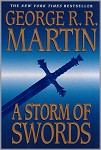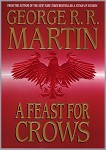The Bloodrider |
Web discoveries
I ask your oath, that will live and die as blood of my blood, riding at my side to keep me safe from harm. “Blood of my blood.” This oath, given when a khal asks a man to be a Bloodrider, is the essence of the Bloodrider’s calling. Better horsemen than the mounted Knights of Westeros, the Bloodriders are the consummate warrior elite of the Dothraki Sea. They are the best riders in the eastern lands of the horselords and the most honourable caste within Dothraki society. They are ranked only below the khal (and ostensibly the khaleesi) in the tribe’s hierarchy. Bloodriders are sworn to one khal and one khalasar. To understand a Bloodrider, one must understand the relationship between a Bloodrider and his khal. While reminiscent on the surface to the bond between Kingsguard and king in Westeros, the trust, joining, and friendship that mark the bond between Bloodrider and khal could not be more dissimilar. The Kingsguard are loyal to the position of king and are primarily guardians of that position, while Bloodriders are like kin to the man who is the khal. There is no one in a Dothraki khalasar closer to the khal than his Bloodriders, not even the khaleesi. The Dothraki bias against women is evident here, for although the Bloodriders may participate in the rituals associated with the khaleesi, at no time are they completely answerable to her (depending on her relationship to the khal). They are like blood brothers to the khal and are kept closer to the centre of the khalasar than anyone else. The Bloodriders are like a shadow — always there to help him in his duties, to share his joys, and to vanquish his enemies. They are a khal’s fiercest friends; they are blood of his blood. They have been known to share nearly everything that the khal owns: his wine, his tent, even his wives. The only exception is the khal’s horse, for a mount belongs to only one man. The ancient traditions of the Dothraki hold that when a khal dies, his Bloodriders are to die with him, to ride at his side in the night lands. When a khal falls in battle, his Bloodriders live with vengeance in their hearts and attempt to avenge their fallen leader. When their revenge for their fallen khal is complete, however, their lives are also at an end. The last ritual that a Bloodrider is expected to perform is to bring the khaleesi to Vaes Dothrak. Examples of Bloodriders: Haggo, Cohollo, Qotho RequirementsTo become a Bloodrider, a character must fulfill all the following criteria: GENDER: Male Note: In the case of the khal’s death, the Bloodrider is required to escort the khaleesi to Vaes Dothrak, and then join his khal in death. Failure to do so results in a loss of the following Class Abilities: Khalasar’s Might, Bloodguard, Bloodguard’s Vigilance, Blood of My Blood. Additionally, the Bloodrider earns the Defect Stigma at 3 BP, and may lose some or all Influence Points. The character can gain no further Levels in Bloodrider, since no other khalasar will accept him. Hit PointsBloodriders gain 2 Hit Points + Constitution Modifier per Level. Class Skills:The Bloodrider’s Class Skills (and the key ability for each Skill) are: Balance (Dex), Climb (Str), Handle Animal (Cha), Intimidate (Cha), Jump (Str), Knowledge: Local Area (Int), Listen (Wis), Profession (Wis), Ride (Dex), Spot (Wis), Survival (Wis) and Use Rope (Dex). Skill PointsAt each Level, Bloodriders get 3 + Int Modifier; humans gain +1 bonus Influence PointsAt each Level, Bloodriders gain 2 + Cha Modifier. Weapon and Armour Proficiency Born to the SaddleBarring infirmity, the Dothraki spend their entire lives on horseback. Beginning at 1st Level, a Bloodrider receives a +1 competence bonus to all Ride checks (see Table). This bonus increases by +1 at every Level. Raised StatusBloodriders are considered Social Status Rank 2 in the khalasar, equal to one who is named ko. They normally have the Raised Status Feat for free, raising their Base Influence to 15, on par with many khaleesi. Although especially strong-willed khaleesi (like Daenerys) may gain more Influence over the khal or khalasar, this is quite rare. As an optional rule, Bloodriders get a +2 to social Skill checks. ToughBloodriders are amongst the hardiest of all Dothraki. They gain the Bonus Feat Tough at 1st Level, and again at 7th Level. Steer with the KneesMost combat is done primarily from horseback, whether raids on villages or wars with other khalasars. At 2nd Level, a Bloodrider can always Take 10 on a Ride check, even if stress and distractions would normally prevent the Bloodrider from doing so. The character can also Take 10 on Ride checks during combat. SurvivorBloodriders are intimately familiar with the Dothraki Sea and how best to subsist in that harsh land. At 2nd Level, a Bloodrider receives a +4 bonus to all Survival checks, including tracking checks, made in the Dothraki Sea. Defensive RidingA Dothraki depends on his steed in combat. At 3rd Level, a Dothraki gains a +1 bonus to defence checks, but only while mounted. This bonus increase to +2 at 6th Level, and +3 at 9th Level, and stacks with similar Feats and Special Abilities. Khalasar’s MightWhile the prowess of individual Dothraki warriors is legendary, the might of the combined khalasar is greater still. At 3rd Level, a Bloodrider performing an aid another action for a Dothraki gains a +1 bonus to the effect. This bonus increases to +2 at 6th Level and +3 at 9th. Mount’s DefenderHorses are the lifeblood of the Dothraki community. Dothraki are as adept at defending their mounts as they are at protecting themselves. Beginning at 4th Level, a Bloodrider may make one extra defencecheck per round to defl ect any successful melee attack against his horse. This action may be taken even if the Dothraki has used Mounted Warrior to defend his horse, and is made at the full Defence Bonus. At 6th Level, the Bloodrider gains a +2 bonus to this defence roll, which increases to +4 at 8th Level, and +6 at 10th Level. This Special Ability cannot be used to parry missile weapons. Bonus FeatA Bloodrider gains a bonus Feat at each Level from 5th through 10th, though all prerequisites must be met as normal. Horseman’s LeapAt 5th Level, a Bloodrider may make a Ride check (DC 20) to leap from horseback and land adjacent to the horse, provided his mount is moving no more than twice its base speed. If an enemy is within reach, the Bloodrider may make a charge attack against the target. BloodguardBloodriders are sworn protectors of the khal, the khaleesi, and anyone else the khal places under their protection. Beginning at 7th Level, a Bloodrider may specify one person as his ward. This ward must be selected before Initiative is rolled and cannot be changed for the duration of the combat. If the Bloodrider is within 5 feet of the ward, he may switch places with the designated person before any attack on the ward is rolled. As long as there is sufficient clearance, the Bloodrider may intercept up to four attacks against the ward — each extra defence is made with the standard cumulative -2 penalty. Bloodguard’s VigilanceAt 8th Level, a Bloodrider who has a designated ward may add +4 to Initiative rolls in any situation in which the ward is threatened. This bonus stacks with Improved Initiative and any other Initiative bonuses. Blood of my BloodWhenever a Bloodrider is working towards a task directly for the khal, either on the khal’s direct orders or an action that directly benefits the khal, he receives a +4 circumstance bonus on such efforts. The player may need to justify how an action is relevant to the khal to receive the bonus, and the GM is the final arbiter of when it applies. Additionally, should the khal die, the Bloodrider gains a +8 bonus on any task that leads to a completion of his duties: to revenge the khal’s death, and to see the khaleesi to Vaes Dothrak.
|
|||||||||||||||||||||||||||||||||||||||||||||||||||||||||||||||||||||||||||||||||||||||||||||||||||||||||||||||||||





















